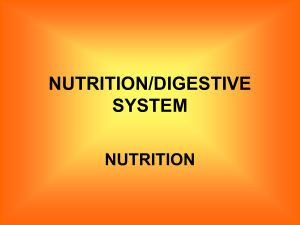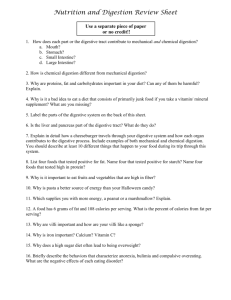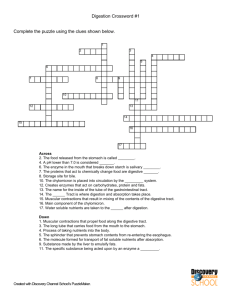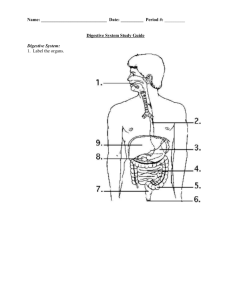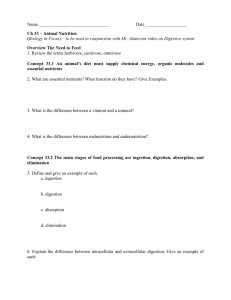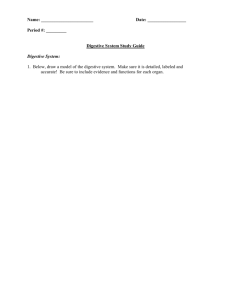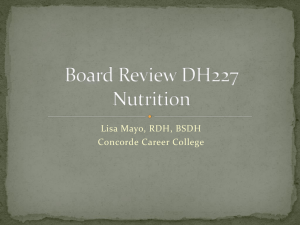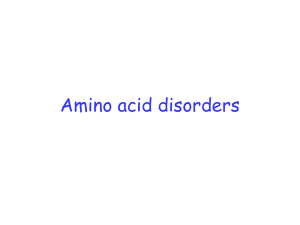Study Guide #2
advertisement
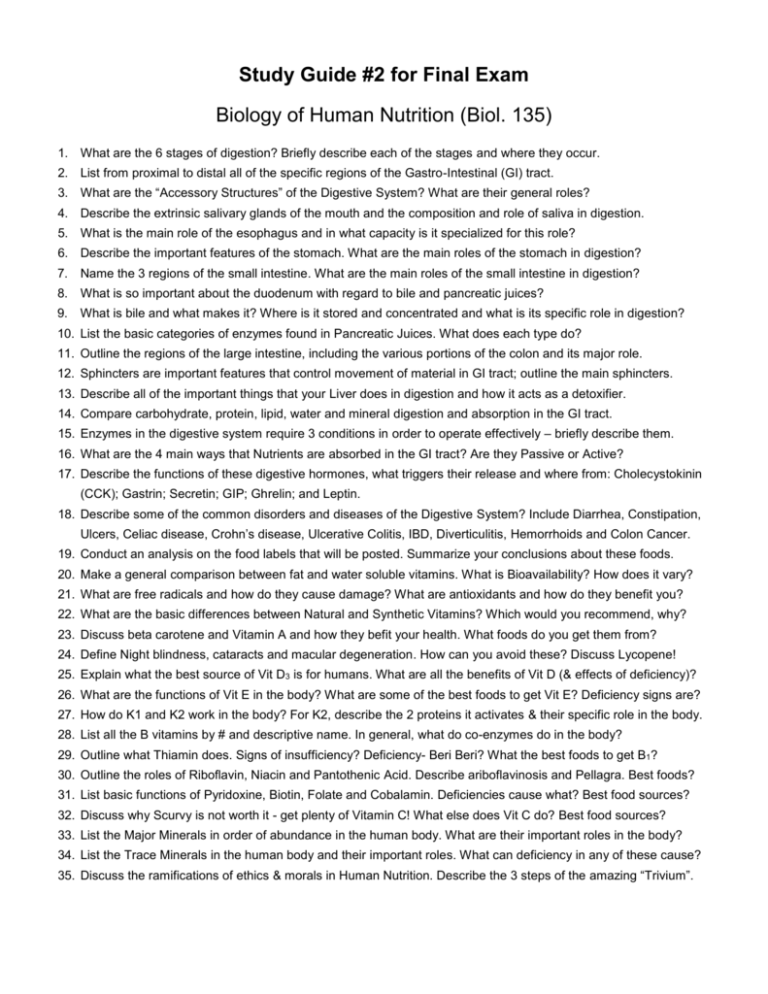
Study Guide #2 for Final Exam Biology of Human Nutrition (Biol. 135) 1. What are the 6 stages of digestion? Briefly describe each of the stages and where they occur. 2. List from proximal to distal all of the specific regions of the Gastro-Intestinal (GI) tract. 3. What are the “Accessory Structures” of the Digestive System? What are their general roles? 4. Describe the extrinsic salivary glands of the mouth and the composition and role of saliva in digestion. 5. What is the main role of the esophagus and in what capacity is it specialized for this role? 6. Describe the important features of the stomach. What are the main roles of the stomach in digestion? 7. Name the 3 regions of the small intestine. What are the main roles of the small intestine in digestion? 8. What is so important about the duodenum with regard to bile and pancreatic juices? 9. What is bile and what makes it? Where is it stored and concentrated and what is its specific role in digestion? 10. List the basic categories of enzymes found in Pancreatic Juices. What does each type do? 11. Outline the regions of the large intestine, including the various portions of the colon and its major role. 12. Sphincters are important features that control movement of material in GI tract; outline the main sphincters. 13. Describe all of the important things that your Liver does in digestion and how it acts as a detoxifier. 14. Compare carbohydrate, protein, lipid, water and mineral digestion and absorption in the GI tract. 15. Enzymes in the digestive system require 3 conditions in order to operate effectively – briefly describe them. 16. What are the 4 main ways that Nutrients are absorbed in the GI tract? Are they Passive or Active? 17. Describe the functions of these digestive hormones, what triggers their release and where from: Cholecystokinin (CCK); Gastrin; Secretin; GIP; Ghrelin; and Leptin. 18. Describe some of the common disorders and diseases of the Digestive System? Include Diarrhea, Constipation, Ulcers, Celiac disease, Crohn’s disease, Ulcerative Colitis, IBD, Diverticulitis, Hemorrhoids and Colon Cancer. 19. Conduct an analysis on the food labels that will be posted. Summarize your conclusions about these foods. 20. Make a general comparison between fat and water soluble vitamins. What is Bioavailability? How does it vary? 21. What are free radicals and how do they cause damage? What are antioxidants and how do they benefit you? 22. What are the basic differences between Natural and Synthetic Vitamins? Which would you recommend, why? 23. Discuss beta carotene and Vitamin A and how they befit your health. What foods do you get them from? 24. Define Night blindness, cataracts and macular degeneration. How can you avoid these? Discuss Lycopene! 25. Explain what the best source of Vit D3 is for humans. What are all the benefits of Vit D (& effects of deficiency)? 26. What are the functions of Vit E in the body? What are some of the best foods to get Vit E? Deficiency signs are? 27. How do K1 and K2 work in the body? For K2, describe the 2 proteins it activates & their specific role in the body. 28. List all the B vitamins by # and descriptive name. In general, what do co-enzymes do in the body? 29. Outline what Thiamin does. Signs of insufficiency? Deficiency- Beri Beri? What the best foods to get B1? 30. Outline the roles of Riboflavin, Niacin and Pantothenic Acid. Describe ariboflavinosis and Pellagra. Best foods? 31. List basic functions of Pyridoxine, Biotin, Folate and Cobalamin. Deficiencies cause what? Best food sources? 32. Discuss why Scurvy is not worth it - get plenty of Vitamin C! What else does Vit C do? Best food sources? 33. List the Major Minerals in order of abundance in the human body. What are their important roles in the body? 34. List the Trace Minerals in the human body and their important roles. What can deficiency in any of these cause? 35. Discuss the ramifications of ethics & morals in Human Nutrition. Describe the 3 steps of the amazing “Trivium”.

